Traffic Management: An Analysis of Autonomous Systems (MIS602)
VerifiedAdded on 2022/10/11
|15
|3567
|10
Report
AI Summary
This report delves into the realm of autonomous traffic control systems, emphasizing the application of advanced technologies like AI and IoT sensors to mitigate traffic congestion. It proposes a controlled system for managing vehicles on the road, analyzing system requirements and offering recommendations for successful implementation. The report explores the concept of autonomous vehicles, categorizing them by automation levels, and discusses the prevailing traffic system, SCATS, highlighting its advantages and disadvantages. The advantages and disadvantages of driverless cars are also discussed. The report concludes with a logical design for the controlled system, providing insights into the future of traffic management and the potential of autonomous technologies. The report also covers the system requirements and the use of the Ant Colony Optimiser algorithm for the proposed system.

Running Head: TRAFFIC CONTROLLING TECHNOLOGY
TRAFFIC CONTROLLING TECHNOLOGY
Name of the Student:
Name of the University:
Author Note:
TRAFFIC CONTROLLING TECHNOLOGY
Name of the Student:
Name of the University:
Author Note:
Paraphrase This Document
Need a fresh take? Get an instant paraphrase of this document with our AI Paraphraser
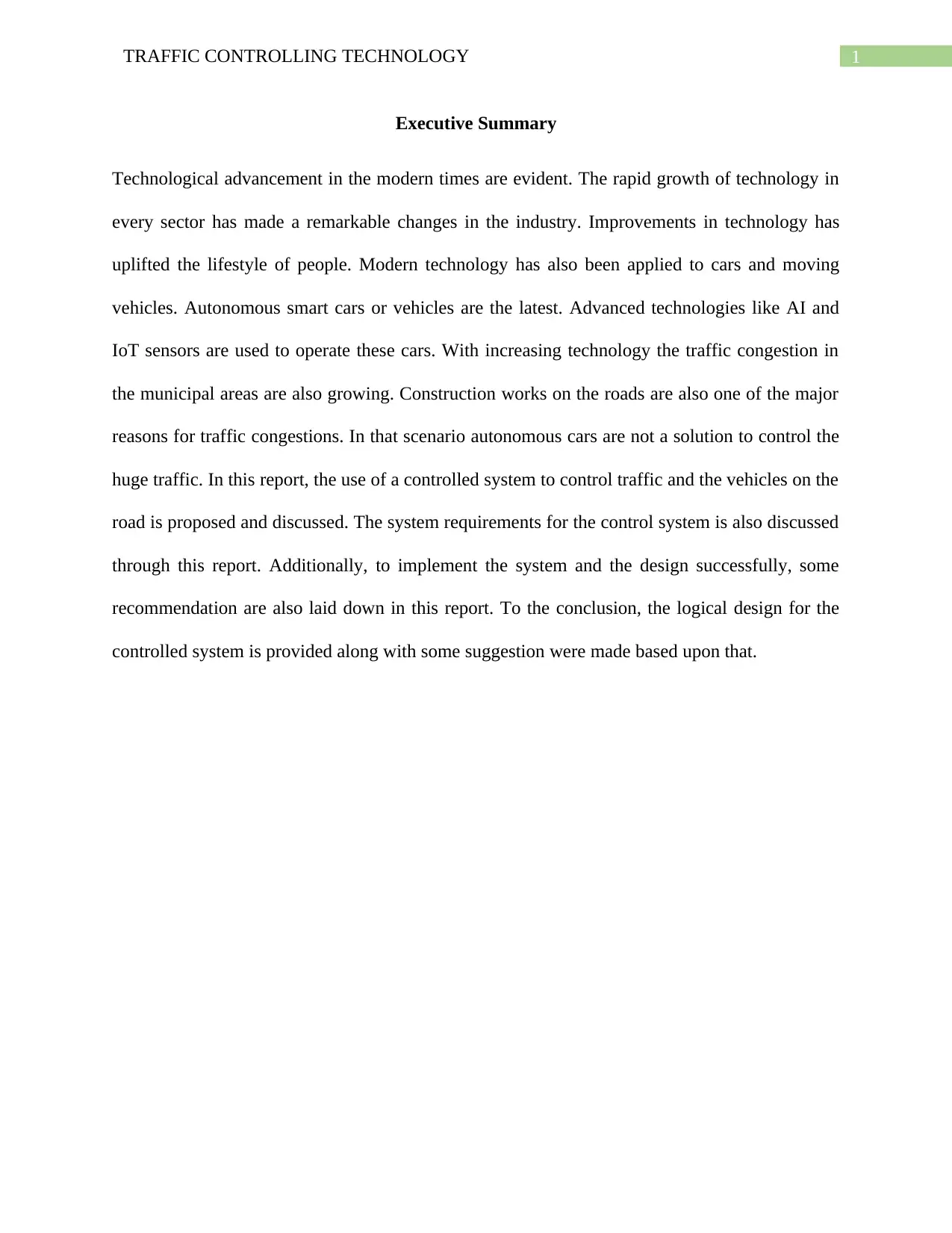
1TRAFFIC CONTROLLING TECHNOLOGY
Executive Summary
Technological advancement in the modern times are evident. The rapid growth of technology in
every sector has made a remarkable changes in the industry. Improvements in technology has
uplifted the lifestyle of people. Modern technology has also been applied to cars and moving
vehicles. Autonomous smart cars or vehicles are the latest. Advanced technologies like AI and
IoT sensors are used to operate these cars. With increasing technology the traffic congestion in
the municipal areas are also growing. Construction works on the roads are also one of the major
reasons for traffic congestions. In that scenario autonomous cars are not a solution to control the
huge traffic. In this report, the use of a controlled system to control traffic and the vehicles on the
road is proposed and discussed. The system requirements for the control system is also discussed
through this report. Additionally, to implement the system and the design successfully, some
recommendation are also laid down in this report. To the conclusion, the logical design for the
controlled system is provided along with some suggestion were made based upon that.
Executive Summary
Technological advancement in the modern times are evident. The rapid growth of technology in
every sector has made a remarkable changes in the industry. Improvements in technology has
uplifted the lifestyle of people. Modern technology has also been applied to cars and moving
vehicles. Autonomous smart cars or vehicles are the latest. Advanced technologies like AI and
IoT sensors are used to operate these cars. With increasing technology the traffic congestion in
the municipal areas are also growing. Construction works on the roads are also one of the major
reasons for traffic congestions. In that scenario autonomous cars are not a solution to control the
huge traffic. In this report, the use of a controlled system to control traffic and the vehicles on the
road is proposed and discussed. The system requirements for the control system is also discussed
through this report. Additionally, to implement the system and the design successfully, some
recommendation are also laid down in this report. To the conclusion, the logical design for the
controlled system is provided along with some suggestion were made based upon that.
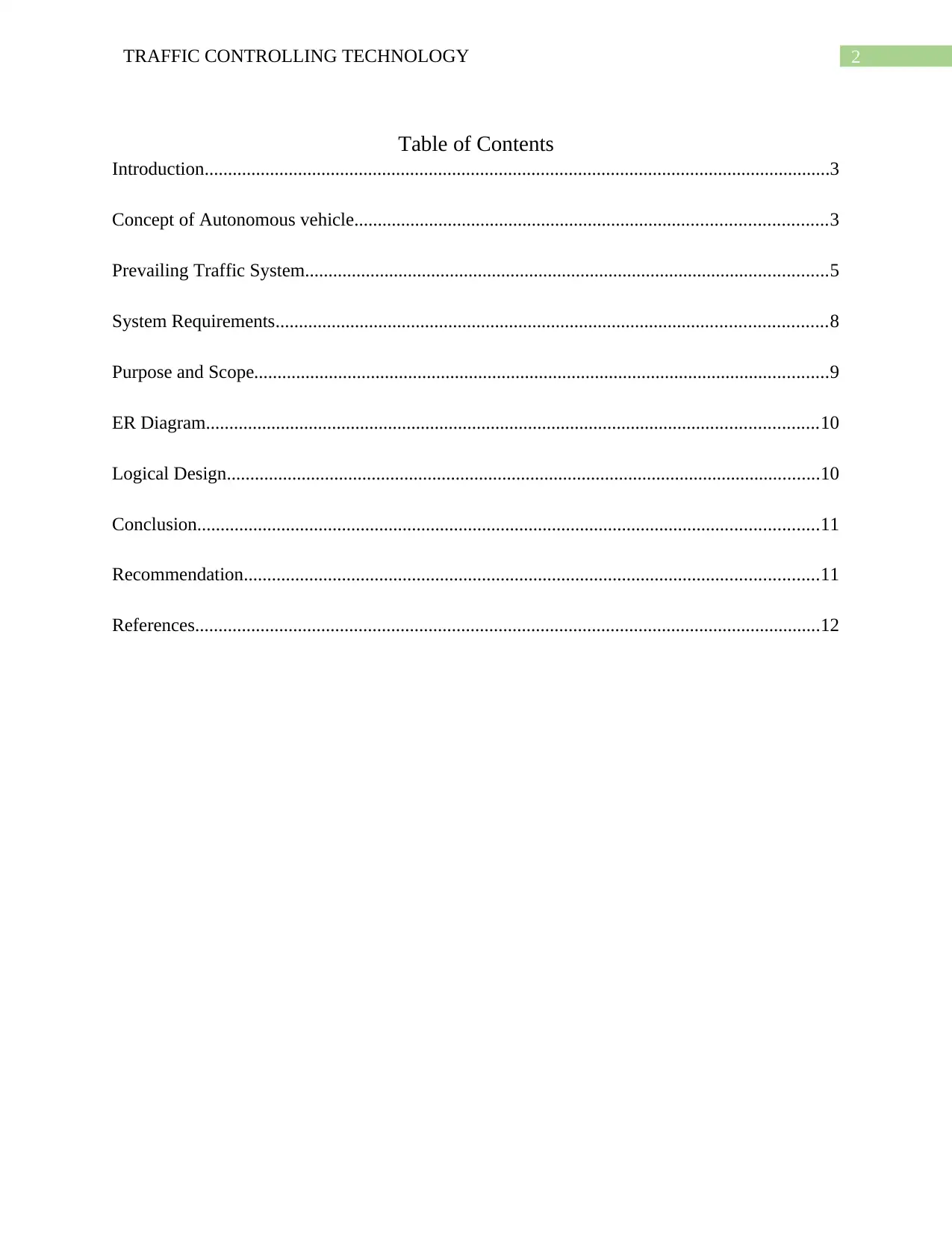
2TRAFFIC CONTROLLING TECHNOLOGY
Table of Contents
Introduction......................................................................................................................................3
Concept of Autonomous vehicle.....................................................................................................3
Prevailing Traffic System................................................................................................................5
System Requirements......................................................................................................................8
Purpose and Scope...........................................................................................................................9
ER Diagram...................................................................................................................................10
Logical Design...............................................................................................................................10
Conclusion.....................................................................................................................................11
Recommendation...........................................................................................................................11
References......................................................................................................................................12
Table of Contents
Introduction......................................................................................................................................3
Concept of Autonomous vehicle.....................................................................................................3
Prevailing Traffic System................................................................................................................5
System Requirements......................................................................................................................8
Purpose and Scope...........................................................................................................................9
ER Diagram...................................................................................................................................10
Logical Design...............................................................................................................................10
Conclusion.....................................................................................................................................11
Recommendation...........................................................................................................................11
References......................................................................................................................................12
⊘ This is a preview!⊘
Do you want full access?
Subscribe today to unlock all pages.

Trusted by 1+ million students worldwide
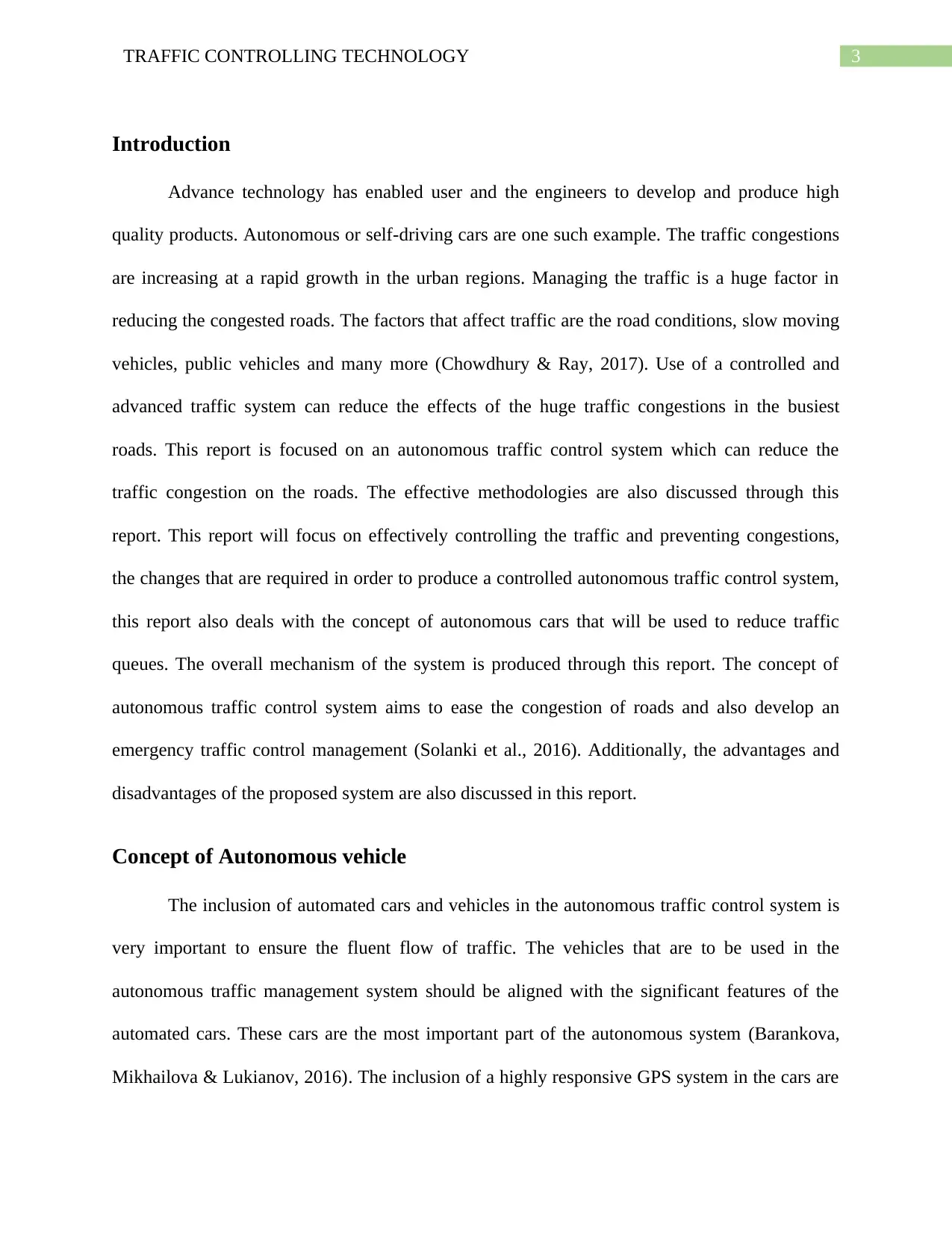
3TRAFFIC CONTROLLING TECHNOLOGY
Introduction
Advance technology has enabled user and the engineers to develop and produce high
quality products. Autonomous or self-driving cars are one such example. The traffic congestions
are increasing at a rapid growth in the urban regions. Managing the traffic is a huge factor in
reducing the congested roads. The factors that affect traffic are the road conditions, slow moving
vehicles, public vehicles and many more (Chowdhury & Ray, 2017). Use of a controlled and
advanced traffic system can reduce the effects of the huge traffic congestions in the busiest
roads. This report is focused on an autonomous traffic control system which can reduce the
traffic congestion on the roads. The effective methodologies are also discussed through this
report. This report will focus on effectively controlling the traffic and preventing congestions,
the changes that are required in order to produce a controlled autonomous traffic control system,
this report also deals with the concept of autonomous cars that will be used to reduce traffic
queues. The overall mechanism of the system is produced through this report. The concept of
autonomous traffic control system aims to ease the congestion of roads and also develop an
emergency traffic control management (Solanki et al., 2016). Additionally, the advantages and
disadvantages of the proposed system are also discussed in this report.
Concept of Autonomous vehicle
The inclusion of automated cars and vehicles in the autonomous traffic control system is
very important to ensure the fluent flow of traffic. The vehicles that are to be used in the
autonomous traffic management system should be aligned with the significant features of the
automated cars. These cars are the most important part of the autonomous system (Barankova,
Mikhailova & Lukianov, 2016). The inclusion of a highly responsive GPS system in the cars are
Introduction
Advance technology has enabled user and the engineers to develop and produce high
quality products. Autonomous or self-driving cars are one such example. The traffic congestions
are increasing at a rapid growth in the urban regions. Managing the traffic is a huge factor in
reducing the congested roads. The factors that affect traffic are the road conditions, slow moving
vehicles, public vehicles and many more (Chowdhury & Ray, 2017). Use of a controlled and
advanced traffic system can reduce the effects of the huge traffic congestions in the busiest
roads. This report is focused on an autonomous traffic control system which can reduce the
traffic congestion on the roads. The effective methodologies are also discussed through this
report. This report will focus on effectively controlling the traffic and preventing congestions,
the changes that are required in order to produce a controlled autonomous traffic control system,
this report also deals with the concept of autonomous cars that will be used to reduce traffic
queues. The overall mechanism of the system is produced through this report. The concept of
autonomous traffic control system aims to ease the congestion of roads and also develop an
emergency traffic control management (Solanki et al., 2016). Additionally, the advantages and
disadvantages of the proposed system are also discussed in this report.
Concept of Autonomous vehicle
The inclusion of automated cars and vehicles in the autonomous traffic control system is
very important to ensure the fluent flow of traffic. The vehicles that are to be used in the
autonomous traffic management system should be aligned with the significant features of the
automated cars. These cars are the most important part of the autonomous system (Barankova,
Mikhailova & Lukianov, 2016). The inclusion of a highly responsive GPS system in the cars are
Paraphrase This Document
Need a fresh take? Get an instant paraphrase of this document with our AI Paraphraser

4TRAFFIC CONTROLLING TECHNOLOGY
very important as these systems will help to track the cars and route them to the desired
destination. The automated cars are categorized into different levels according to the level of
autonomy that the car provides (Ulbrich et al., 2017). The levels of the autonomous cars are
stated briefly:
Level 0: These type of cars have no automation and are mostly seen in the manual traffic control
system. It is very evident that these type of cars cannot run automatically. It is also a fact that this
level of cars need a driver to drive the vehicle and make the car move (Islam et al., 2016). It can
be concluded, that these type of cars should not be used in the autonomous traffic control system.
Level 1: This level of the cars are also known as Driver assistance level. This level of automation
provides some level of automation in the vehicle. The vehicles that fall under this category has
the power of adaptive control like the cruise control and provides the feature of lane keep assist
according to the driver in some exhausting conditions. This level of automation also provides the
car a feature to keep a safe distance between two vehicles (Heikoop et al., 2017). Additionally,
the lane keep assist also helps to maintain the bumps in the roads with the help of the nudge
identification and is very helpful for the driver in controlling the car. This level of cars cannot
also be considered for the autonomous traffic control system.
Level 2: This level of automation provides partial automation to the cars. The vehicles that are
associated with this level provide control of the steering as well as the speed. This feature is
important and significant for the use of the car in the autonomous traffic system as this will
provided some level of automation, keep safe distance between vehicles and also have the
control of the speed and the steering, which means this level of cars can be considered to be used
in the autonomous traffic system. This will ensure the safety on the roads and also keep the
perfect lane of the car.
very important as these systems will help to track the cars and route them to the desired
destination. The automated cars are categorized into different levels according to the level of
autonomy that the car provides (Ulbrich et al., 2017). The levels of the autonomous cars are
stated briefly:
Level 0: These type of cars have no automation and are mostly seen in the manual traffic control
system. It is very evident that these type of cars cannot run automatically. It is also a fact that this
level of cars need a driver to drive the vehicle and make the car move (Islam et al., 2016). It can
be concluded, that these type of cars should not be used in the autonomous traffic control system.
Level 1: This level of the cars are also known as Driver assistance level. This level of automation
provides some level of automation in the vehicle. The vehicles that fall under this category has
the power of adaptive control like the cruise control and provides the feature of lane keep assist
according to the driver in some exhausting conditions. This level of automation also provides the
car a feature to keep a safe distance between two vehicles (Heikoop et al., 2017). Additionally,
the lane keep assist also helps to maintain the bumps in the roads with the help of the nudge
identification and is very helpful for the driver in controlling the car. This level of cars cannot
also be considered for the autonomous traffic control system.
Level 2: This level of automation provides partial automation to the cars. The vehicles that are
associated with this level provide control of the steering as well as the speed. This feature is
important and significant for the use of the car in the autonomous traffic system as this will
provided some level of automation, keep safe distance between vehicles and also have the
control of the speed and the steering, which means this level of cars can be considered to be used
in the autonomous traffic system. This will ensure the safety on the roads and also keep the
perfect lane of the car.

5TRAFFIC CONTROLLING TECHNOLOGY
Level 3: This level of automation provides Conditional automation to the cars. These cars are
categorised as self-driving cars, which means these cars can drive themselves (Kopardekar et al.,
2016). However, there are many constraints to this level of automated cars. There are speed
limitations, access limitation and needs an ideal condition in order to move and have a smooth
flow of the car. This level of automated cars also cannot be considered for the automated traffic
system because of the limitations.
Level 4: These level provides high automation. This level does not require any human interaction
to drive themselves. This level of cars can be very useful in the automated traffic control system
because of the high automation and the ability to drive the vehicle without any human interaction
(Payre et al., 2017).
Level 5: This is the most effective and most efficient level of automation and provides full
automation. These type of cars are known to be true driverless cars. These cars are equipped with
artificial intelligence effective control of the vehicle. This cars are the most appropriate for the
use in the automated system and reduce the traffic. Artificial technology are very effective in
controlling the autonomous system of the traffic control.
Prevailing Traffic System
One of the traffic control system that is used in Australia is the SCATS or Sydney
Coordinated Adaptive Traffic system and is considered an intelligent system because it controls
all the related timings and the signal phases of the traffic lights or the traffic signals. The system
is capable of finding the best timing according to the situation of the traffic at some point of
time.
Level 3: This level of automation provides Conditional automation to the cars. These cars are
categorised as self-driving cars, which means these cars can drive themselves (Kopardekar et al.,
2016). However, there are many constraints to this level of automated cars. There are speed
limitations, access limitation and needs an ideal condition in order to move and have a smooth
flow of the car. This level of automated cars also cannot be considered for the automated traffic
system because of the limitations.
Level 4: These level provides high automation. This level does not require any human interaction
to drive themselves. This level of cars can be very useful in the automated traffic control system
because of the high automation and the ability to drive the vehicle without any human interaction
(Payre et al., 2017).
Level 5: This is the most effective and most efficient level of automation and provides full
automation. These type of cars are known to be true driverless cars. These cars are equipped with
artificial intelligence effective control of the vehicle. This cars are the most appropriate for the
use in the automated system and reduce the traffic. Artificial technology are very effective in
controlling the autonomous system of the traffic control.
Prevailing Traffic System
One of the traffic control system that is used in Australia is the SCATS or Sydney
Coordinated Adaptive Traffic system and is considered an intelligent system because it controls
all the related timings and the signal phases of the traffic lights or the traffic signals. The system
is capable of finding the best timing according to the situation of the traffic at some point of
time.
⊘ This is a preview!⊘
Do you want full access?
Subscribe today to unlock all pages.

Trusted by 1+ million students worldwide
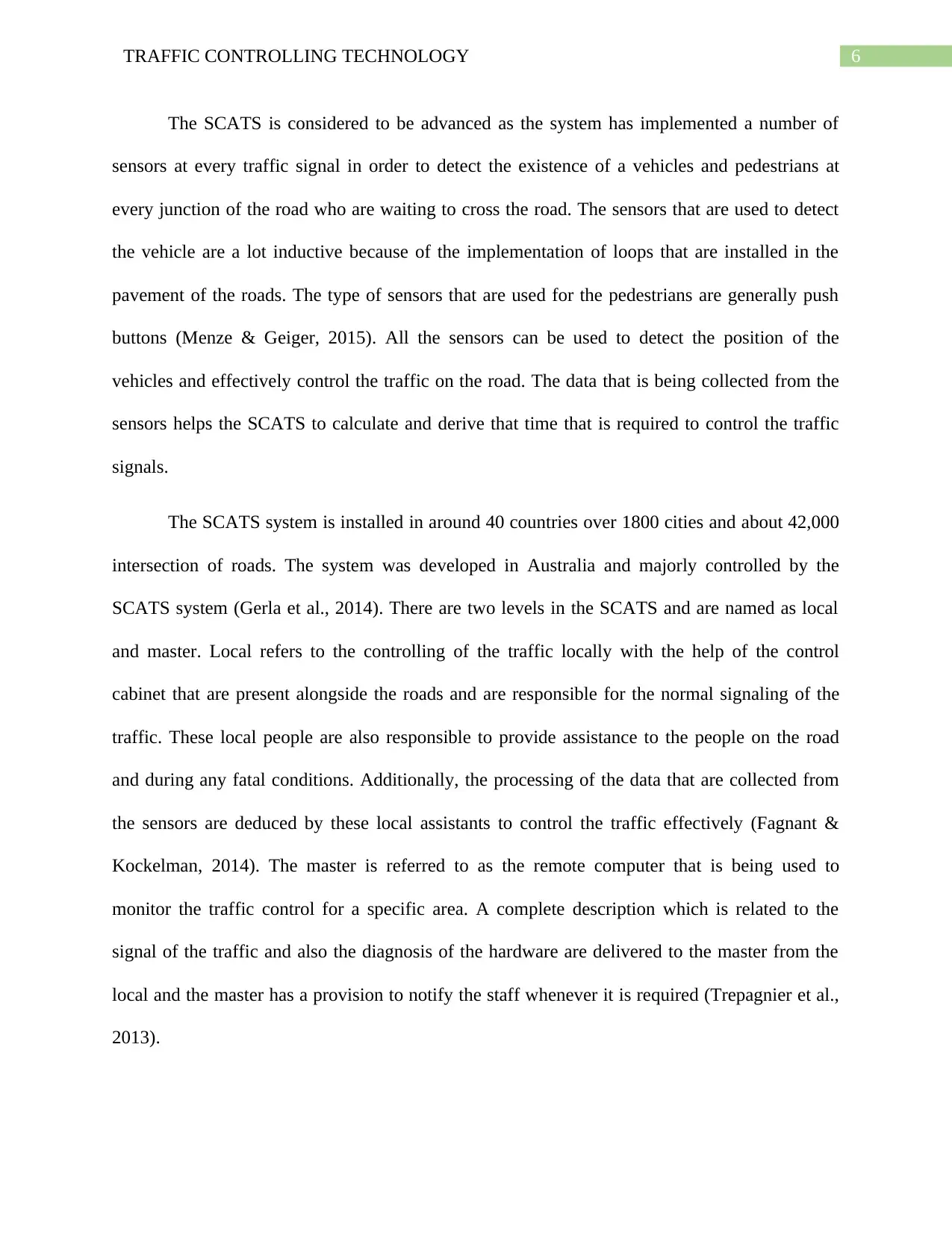
6TRAFFIC CONTROLLING TECHNOLOGY
The SCATS is considered to be advanced as the system has implemented a number of
sensors at every traffic signal in order to detect the existence of a vehicles and pedestrians at
every junction of the road who are waiting to cross the road. The sensors that are used to detect
the vehicle are a lot inductive because of the implementation of loops that are installed in the
pavement of the roads. The type of sensors that are used for the pedestrians are generally push
buttons (Menze & Geiger, 2015). All the sensors can be used to detect the position of the
vehicles and effectively control the traffic on the road. The data that is being collected from the
sensors helps the SCATS to calculate and derive that time that is required to control the traffic
signals.
The SCATS system is installed in around 40 countries over 1800 cities and about 42,000
intersection of roads. The system was developed in Australia and majorly controlled by the
SCATS system (Gerla et al., 2014). There are two levels in the SCATS and are named as local
and master. Local refers to the controlling of the traffic locally with the help of the control
cabinet that are present alongside the roads and are responsible for the normal signaling of the
traffic. These local people are also responsible to provide assistance to the people on the road
and during any fatal conditions. Additionally, the processing of the data that are collected from
the sensors are deduced by these local assistants to control the traffic effectively (Fagnant &
Kockelman, 2014). The master is referred to as the remote computer that is being used to
monitor the traffic control for a specific area. A complete description which is related to the
signal of the traffic and also the diagnosis of the hardware are delivered to the master from the
local and the master has a provision to notify the staff whenever it is required (Trepagnier et al.,
2013).
The SCATS is considered to be advanced as the system has implemented a number of
sensors at every traffic signal in order to detect the existence of a vehicles and pedestrians at
every junction of the road who are waiting to cross the road. The sensors that are used to detect
the vehicle are a lot inductive because of the implementation of loops that are installed in the
pavement of the roads. The type of sensors that are used for the pedestrians are generally push
buttons (Menze & Geiger, 2015). All the sensors can be used to detect the position of the
vehicles and effectively control the traffic on the road. The data that is being collected from the
sensors helps the SCATS to calculate and derive that time that is required to control the traffic
signals.
The SCATS system is installed in around 40 countries over 1800 cities and about 42,000
intersection of roads. The system was developed in Australia and majorly controlled by the
SCATS system (Gerla et al., 2014). There are two levels in the SCATS and are named as local
and master. Local refers to the controlling of the traffic locally with the help of the control
cabinet that are present alongside the roads and are responsible for the normal signaling of the
traffic. These local people are also responsible to provide assistance to the people on the road
and during any fatal conditions. Additionally, the processing of the data that are collected from
the sensors are deduced by these local assistants to control the traffic effectively (Fagnant &
Kockelman, 2014). The master is referred to as the remote computer that is being used to
monitor the traffic control for a specific area. A complete description which is related to the
signal of the traffic and also the diagnosis of the hardware are delivered to the master from the
local and the master has a provision to notify the staff whenever it is required (Trepagnier et al.,
2013).
Paraphrase This Document
Need a fresh take? Get an instant paraphrase of this document with our AI Paraphraser
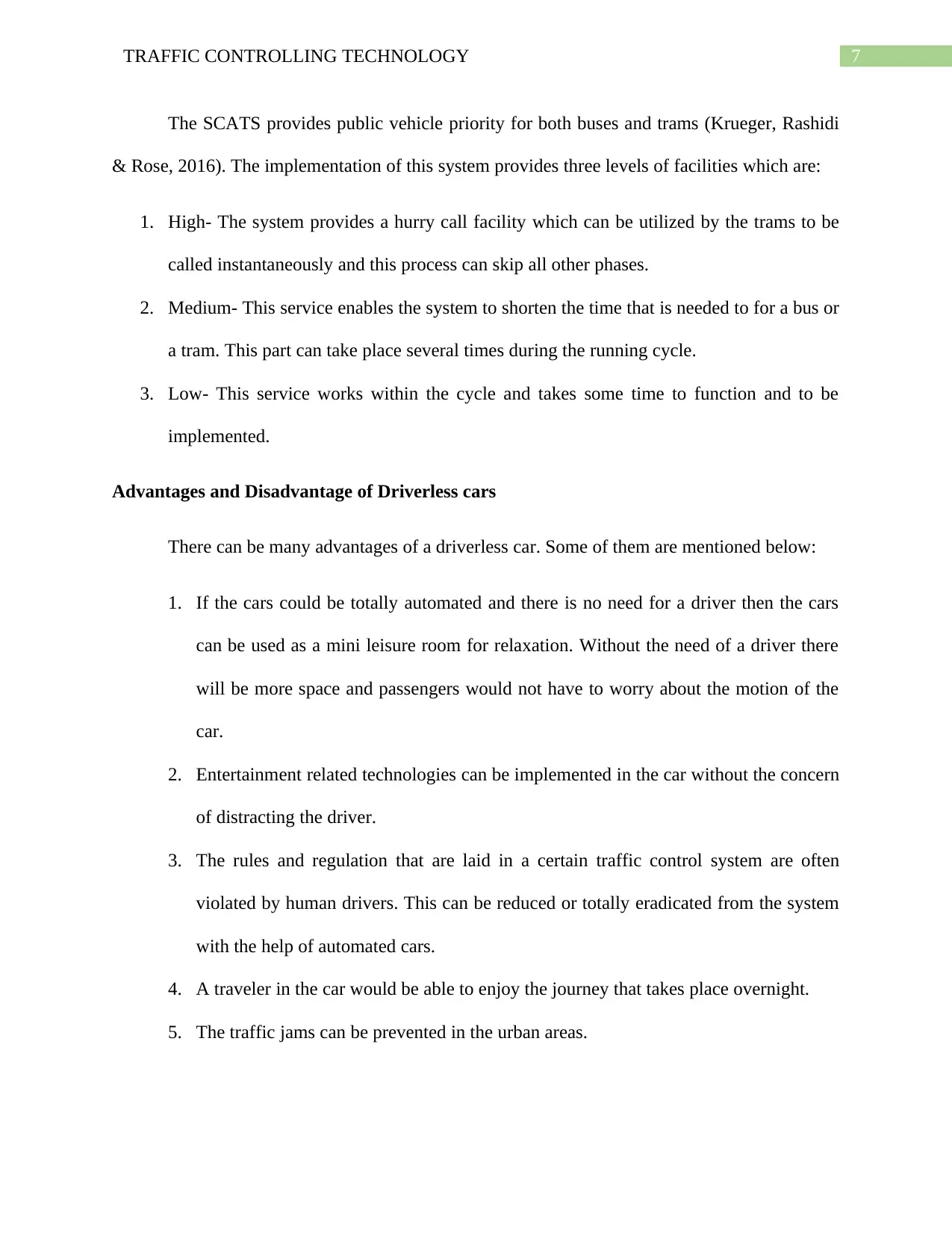
7TRAFFIC CONTROLLING TECHNOLOGY
The SCATS provides public vehicle priority for both buses and trams (Krueger, Rashidi
& Rose, 2016). The implementation of this system provides three levels of facilities which are:
1. High- The system provides a hurry call facility which can be utilized by the trams to be
called instantaneously and this process can skip all other phases.
2. Medium- This service enables the system to shorten the time that is needed to for a bus or
a tram. This part can take place several times during the running cycle.
3. Low- This service works within the cycle and takes some time to function and to be
implemented.
Advantages and Disadvantage of Driverless cars
There can be many advantages of a driverless car. Some of them are mentioned below:
1. If the cars could be totally automated and there is no need for a driver then the cars
can be used as a mini leisure room for relaxation. Without the need of a driver there
will be more space and passengers would not have to worry about the motion of the
car.
2. Entertainment related technologies can be implemented in the car without the concern
of distracting the driver.
3. The rules and regulation that are laid in a certain traffic control system are often
violated by human drivers. This can be reduced or totally eradicated from the system
with the help of automated cars.
4. A traveler in the car would be able to enjoy the journey that takes place overnight.
5. The traffic jams can be prevented in the urban areas.
The SCATS provides public vehicle priority for both buses and trams (Krueger, Rashidi
& Rose, 2016). The implementation of this system provides three levels of facilities which are:
1. High- The system provides a hurry call facility which can be utilized by the trams to be
called instantaneously and this process can skip all other phases.
2. Medium- This service enables the system to shorten the time that is needed to for a bus or
a tram. This part can take place several times during the running cycle.
3. Low- This service works within the cycle and takes some time to function and to be
implemented.
Advantages and Disadvantage of Driverless cars
There can be many advantages of a driverless car. Some of them are mentioned below:
1. If the cars could be totally automated and there is no need for a driver then the cars
can be used as a mini leisure room for relaxation. Without the need of a driver there
will be more space and passengers would not have to worry about the motion of the
car.
2. Entertainment related technologies can be implemented in the car without the concern
of distracting the driver.
3. The rules and regulation that are laid in a certain traffic control system are often
violated by human drivers. This can be reduced or totally eradicated from the system
with the help of automated cars.
4. A traveler in the car would be able to enjoy the journey that takes place overnight.
5. The traffic jams can be prevented in the urban areas.
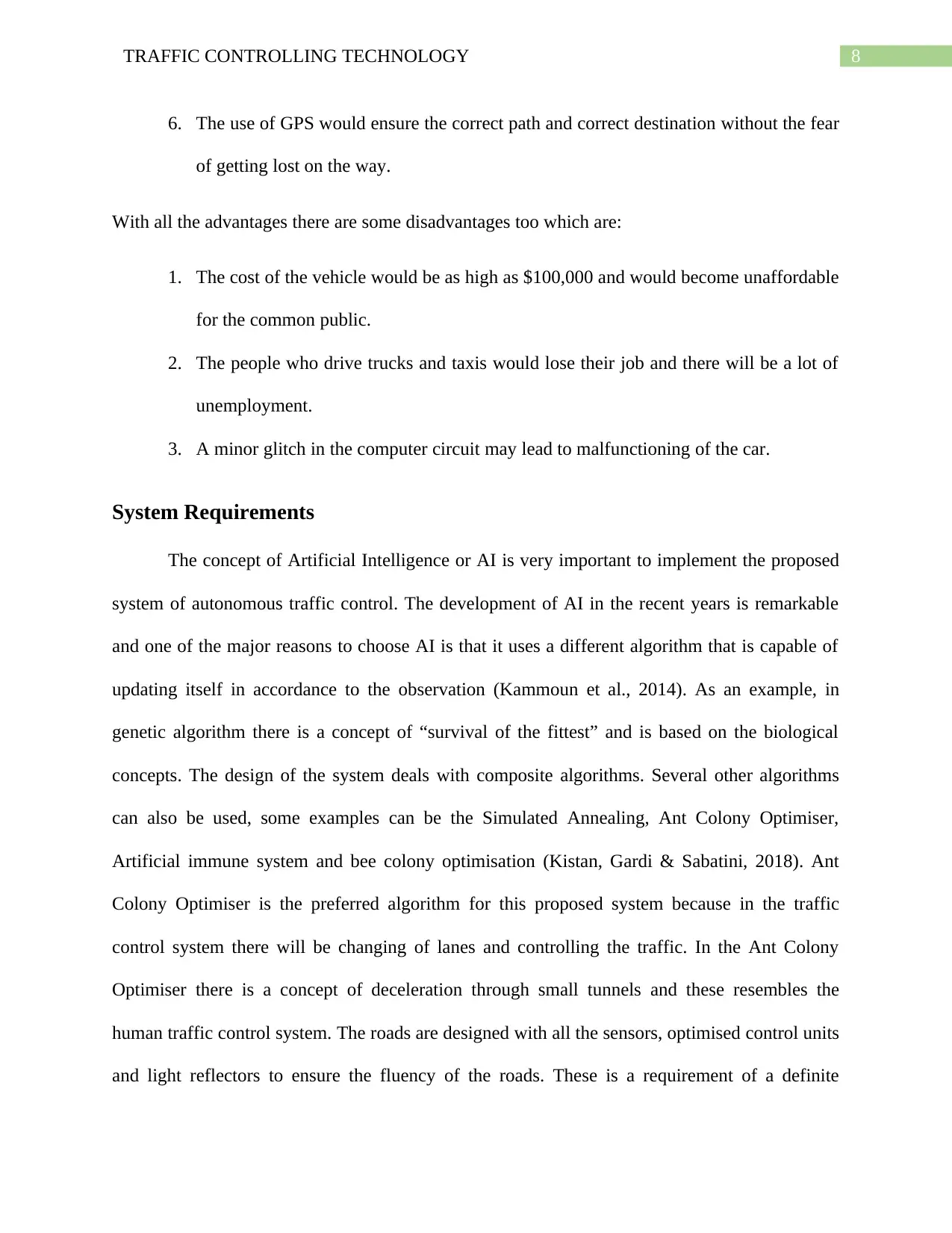
8TRAFFIC CONTROLLING TECHNOLOGY
6. The use of GPS would ensure the correct path and correct destination without the fear
of getting lost on the way.
With all the advantages there are some disadvantages too which are:
1. The cost of the vehicle would be as high as $100,000 and would become unaffordable
for the common public.
2. The people who drive trucks and taxis would lose their job and there will be a lot of
unemployment.
3. A minor glitch in the computer circuit may lead to malfunctioning of the car.
System Requirements
The concept of Artificial Intelligence or AI is very important to implement the proposed
system of autonomous traffic control. The development of AI in the recent years is remarkable
and one of the major reasons to choose AI is that it uses a different algorithm that is capable of
updating itself in accordance to the observation (Kammoun et al., 2014). As an example, in
genetic algorithm there is a concept of “survival of the fittest” and is based on the biological
concepts. The design of the system deals with composite algorithms. Several other algorithms
can also be used, some examples can be the Simulated Annealing, Ant Colony Optimiser,
Artificial immune system and bee colony optimisation (Kistan, Gardi & Sabatini, 2018). Ant
Colony Optimiser is the preferred algorithm for this proposed system because in the traffic
control system there will be changing of lanes and controlling the traffic. In the Ant Colony
Optimiser there is a concept of deceleration through small tunnels and these resembles the
human traffic control system. The roads are designed with all the sensors, optimised control units
and light reflectors to ensure the fluency of the roads. These is a requirement of a definite
6. The use of GPS would ensure the correct path and correct destination without the fear
of getting lost on the way.
With all the advantages there are some disadvantages too which are:
1. The cost of the vehicle would be as high as $100,000 and would become unaffordable
for the common public.
2. The people who drive trucks and taxis would lose their job and there will be a lot of
unemployment.
3. A minor glitch in the computer circuit may lead to malfunctioning of the car.
System Requirements
The concept of Artificial Intelligence or AI is very important to implement the proposed
system of autonomous traffic control. The development of AI in the recent years is remarkable
and one of the major reasons to choose AI is that it uses a different algorithm that is capable of
updating itself in accordance to the observation (Kammoun et al., 2014). As an example, in
genetic algorithm there is a concept of “survival of the fittest” and is based on the biological
concepts. The design of the system deals with composite algorithms. Several other algorithms
can also be used, some examples can be the Simulated Annealing, Ant Colony Optimiser,
Artificial immune system and bee colony optimisation (Kistan, Gardi & Sabatini, 2018). Ant
Colony Optimiser is the preferred algorithm for this proposed system because in the traffic
control system there will be changing of lanes and controlling the traffic. In the Ant Colony
Optimiser there is a concept of deceleration through small tunnels and these resembles the
human traffic control system. The roads are designed with all the sensors, optimised control units
and light reflectors to ensure the fluency of the roads. These is a requirement of a definite
⊘ This is a preview!⊘
Do you want full access?
Subscribe today to unlock all pages.

Trusted by 1+ million students worldwide
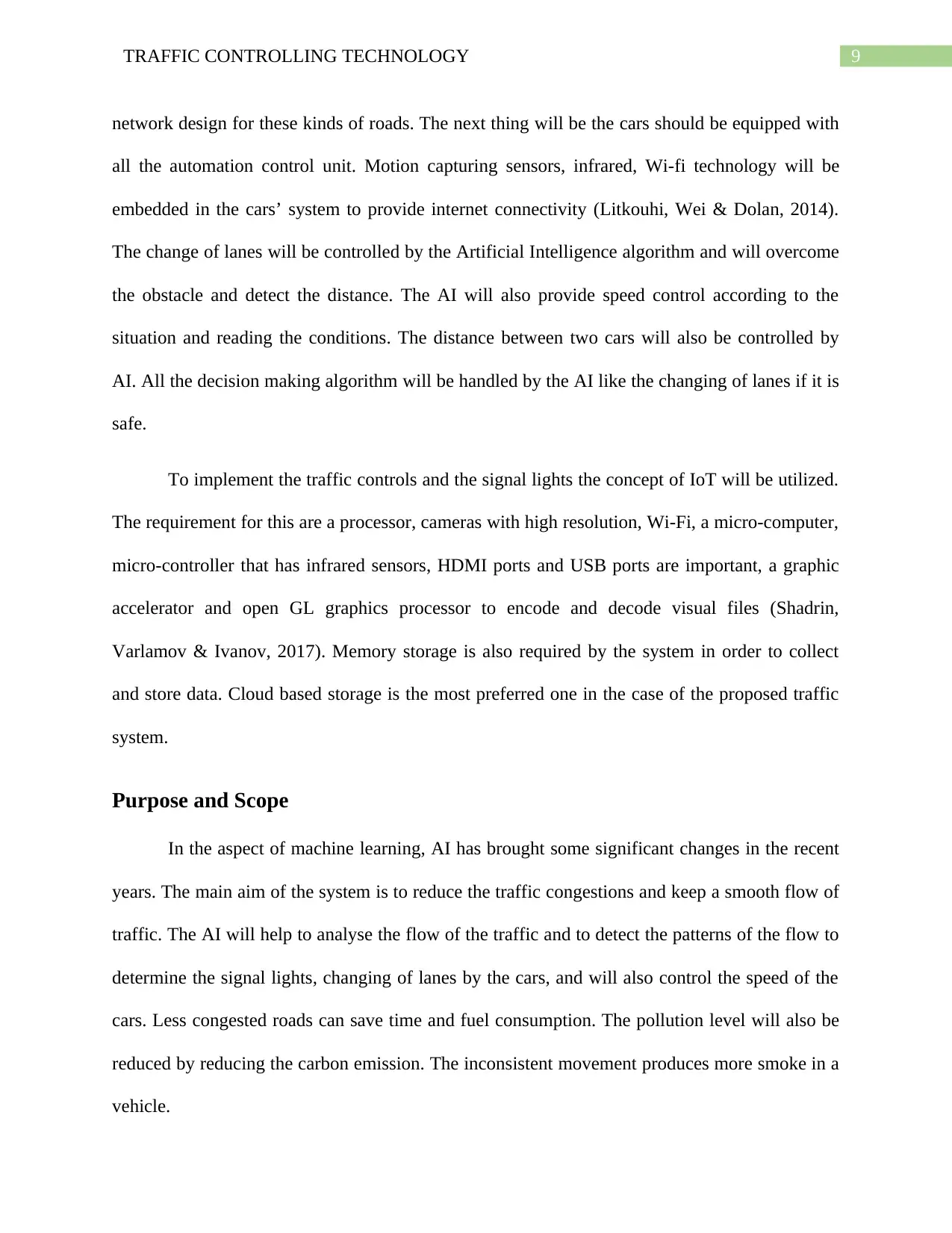
9TRAFFIC CONTROLLING TECHNOLOGY
network design for these kinds of roads. The next thing will be the cars should be equipped with
all the automation control unit. Motion capturing sensors, infrared, Wi-fi technology will be
embedded in the cars’ system to provide internet connectivity (Litkouhi, Wei & Dolan, 2014).
The change of lanes will be controlled by the Artificial Intelligence algorithm and will overcome
the obstacle and detect the distance. The AI will also provide speed control according to the
situation and reading the conditions. The distance between two cars will also be controlled by
AI. All the decision making algorithm will be handled by the AI like the changing of lanes if it is
safe.
To implement the traffic controls and the signal lights the concept of IoT will be utilized.
The requirement for this are a processor, cameras with high resolution, Wi-Fi, a micro-computer,
micro-controller that has infrared sensors, HDMI ports and USB ports are important, a graphic
accelerator and open GL graphics processor to encode and decode visual files (Shadrin,
Varlamov & Ivanov, 2017). Memory storage is also required by the system in order to collect
and store data. Cloud based storage is the most preferred one in the case of the proposed traffic
system.
Purpose and Scope
In the aspect of machine learning, AI has brought some significant changes in the recent
years. The main aim of the system is to reduce the traffic congestions and keep a smooth flow of
traffic. The AI will help to analyse the flow of the traffic and to detect the patterns of the flow to
determine the signal lights, changing of lanes by the cars, and will also control the speed of the
cars. Less congested roads can save time and fuel consumption. The pollution level will also be
reduced by reducing the carbon emission. The inconsistent movement produces more smoke in a
vehicle.
network design for these kinds of roads. The next thing will be the cars should be equipped with
all the automation control unit. Motion capturing sensors, infrared, Wi-fi technology will be
embedded in the cars’ system to provide internet connectivity (Litkouhi, Wei & Dolan, 2014).
The change of lanes will be controlled by the Artificial Intelligence algorithm and will overcome
the obstacle and detect the distance. The AI will also provide speed control according to the
situation and reading the conditions. The distance between two cars will also be controlled by
AI. All the decision making algorithm will be handled by the AI like the changing of lanes if it is
safe.
To implement the traffic controls and the signal lights the concept of IoT will be utilized.
The requirement for this are a processor, cameras with high resolution, Wi-Fi, a micro-computer,
micro-controller that has infrared sensors, HDMI ports and USB ports are important, a graphic
accelerator and open GL graphics processor to encode and decode visual files (Shadrin,
Varlamov & Ivanov, 2017). Memory storage is also required by the system in order to collect
and store data. Cloud based storage is the most preferred one in the case of the proposed traffic
system.
Purpose and Scope
In the aspect of machine learning, AI has brought some significant changes in the recent
years. The main aim of the system is to reduce the traffic congestions and keep a smooth flow of
traffic. The AI will help to analyse the flow of the traffic and to detect the patterns of the flow to
determine the signal lights, changing of lanes by the cars, and will also control the speed of the
cars. Less congested roads can save time and fuel consumption. The pollution level will also be
reduced by reducing the carbon emission. The inconsistent movement produces more smoke in a
vehicle.
Paraphrase This Document
Need a fresh take? Get an instant paraphrase of this document with our AI Paraphraser
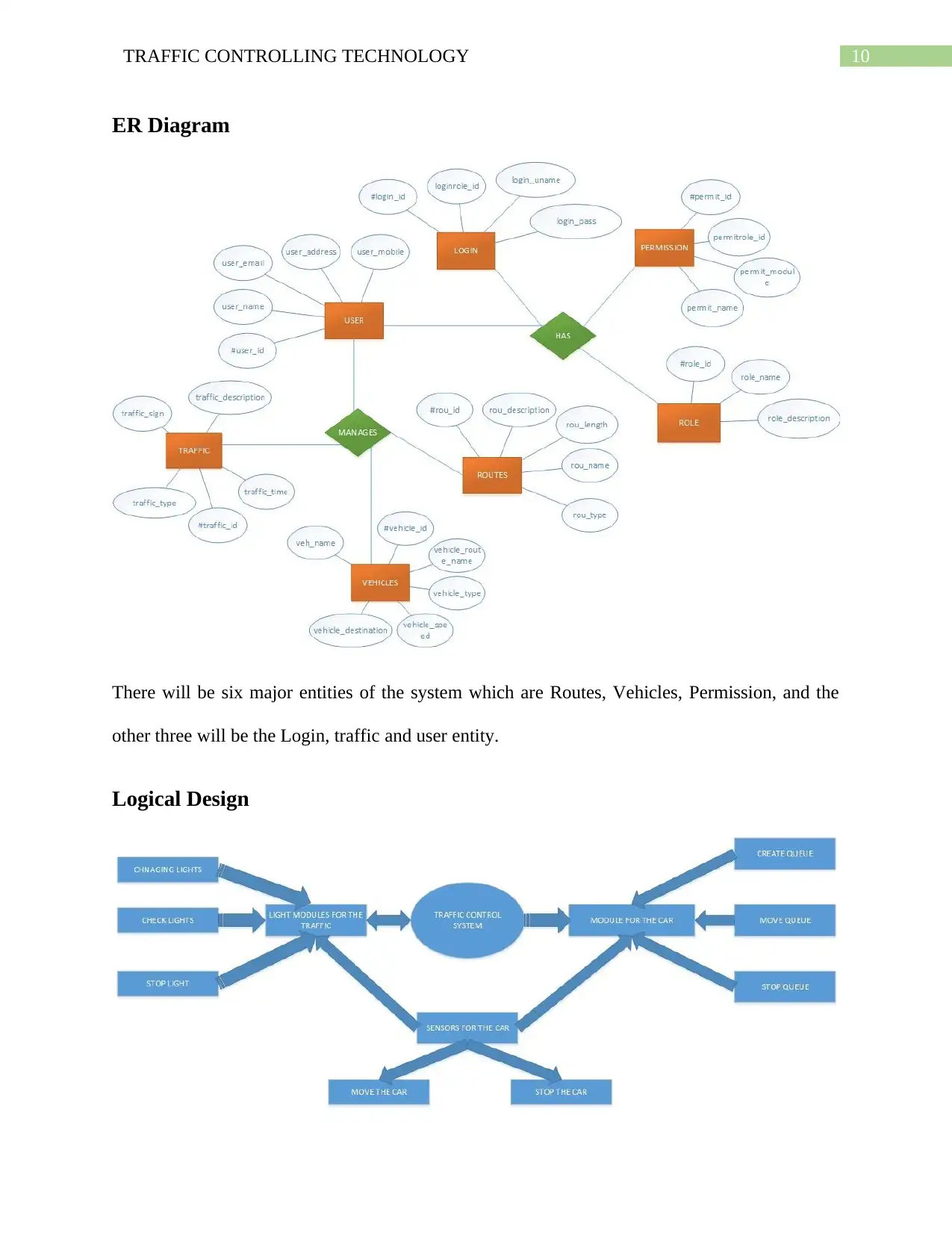
10TRAFFIC CONTROLLING TECHNOLOGY
ER Diagram
There will be six major entities of the system which are Routes, Vehicles, Permission, and the
other three will be the Login, traffic and user entity.
Logical Design
ER Diagram
There will be six major entities of the system which are Routes, Vehicles, Permission, and the
other three will be the Login, traffic and user entity.
Logical Design

11TRAFFIC CONTROLLING TECHNOLOGY
Conclusion
The system is proposed according to the human behaviour in order to reduce the long
traffic queues. The flow of the traffic is controlled by the AI technology and to detect the
patterns also. This system can drastically bring in change to the current road traffic scenario.
However, there are certain limitations like in order to implement this system the infrastructure of
the roads needs to be changed. All the traffic signals needs an upliftment. A good amount of
maintenance is required to control and operate this system. In conclusion, these will be a lot of
challenges in implementing this system. However, implementing this system in a well-organized
and serialized manner can bring in the effect.
Recommendation
A good knowledge of AI and machine learning is required to implement this system.
Trained professional are required to handle the tasks. Data management is very important
because the system will depend on the collected data. A good knowledge of network is also
required to implement this system.
Conclusion
The system is proposed according to the human behaviour in order to reduce the long
traffic queues. The flow of the traffic is controlled by the AI technology and to detect the
patterns also. This system can drastically bring in change to the current road traffic scenario.
However, there are certain limitations like in order to implement this system the infrastructure of
the roads needs to be changed. All the traffic signals needs an upliftment. A good amount of
maintenance is required to control and operate this system. In conclusion, these will be a lot of
challenges in implementing this system. However, implementing this system in a well-organized
and serialized manner can bring in the effect.
Recommendation
A good knowledge of AI and machine learning is required to implement this system.
Trained professional are required to handle the tasks. Data management is very important
because the system will depend on the collected data. A good knowledge of network is also
required to implement this system.
⊘ This is a preview!⊘
Do you want full access?
Subscribe today to unlock all pages.

Trusted by 1+ million students worldwide
1 out of 15
Related Documents
Your All-in-One AI-Powered Toolkit for Academic Success.
+13062052269
info@desklib.com
Available 24*7 on WhatsApp / Email
![[object Object]](/_next/static/media/star-bottom.7253800d.svg)
Unlock your academic potential
Copyright © 2020–2025 A2Z Services. All Rights Reserved. Developed and managed by ZUCOL.




